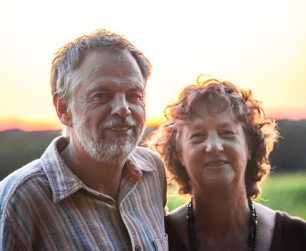“The world is not a rectilinear world, it is a curvilinear world. The heavenly bodies go in a curve because that is the natural way.” George Bernard Shaw
As a teenager, I served a reluctant apprenticeship to my father in his mid-life career change from farm equipment salesman to home builder. I learned the use of tools and materials on dozens of simple ranch homes, using plans drafted by dad on spiral notebook pages. This led me organically, as a young adult, to pursue building and remodeling in Chicago. On weekends, I toured and studied the homes and public buildings designed by Frank Lloyd Wright and his mentor, Louis Sullivan. I was inspired by their freeing of architectural design in this country from its European roots, creating a uniquely American aesthetic which was a synthesis of steel, brick, and stone underpinned by the lines and forms of nature. During the week, I would put these lessons into practice.
Fast forward 40 years. My partner, Susan Walch, and I bought a brick bungalow in Fairfield, Iowa. We spent vast amounts of time renewing the home’s century-old Art and Crafts glory. It was a lovely place, but we often found ourselves in the evenings looking over magazine pictures that inspired us, dreaming of a home that we would someday build.
Then one day, while we were working out of town, we received a phone call telling us that our lovely house was on fire. After we’d made the four-hour drive home, we found a smoldering, total loss. We didn’t know it then, of course, but looking back on this disaster now, I can see that those ashes were the crucible of a boundary-breaking house.
When we decided, after the fire, to build the house we’d been dreaming of, we came to our task with many questions and few answers: How can a house honor and celebrate Mother Nature’s living presence, we asked? And how would we build such a house? Would building with materials that were more natural and less processed bring the dweller closer to the heart of nature? What if the materials—to take a cue from the food movement’s “eat local” slogan—were drawn from our determination that we “build local”? Would the look or feel of local materials make a difference, or be noticeable? And, of course, would the work entailed in sourcing these materials be worth the effort?
It’s been six years now since Susan and I began building what we eventually called the FarmHouse at Hickory Highlands, outside of Fairfield, Iowa, and I can honestly say that we have found answers to those questions and more. In the process, we have hosted over a thousand visitors, from a diverse array of states, nations, ages, occupations, and education levels. These visitors have expressed wonder, appreciation and joy as they’ve visited the house. I believe they’ve been responding to the materials, the design, the artistry, the comfort, and the uplifting feeling the space conveys. We did not intend to create a magical place but, magically, that is what happened.
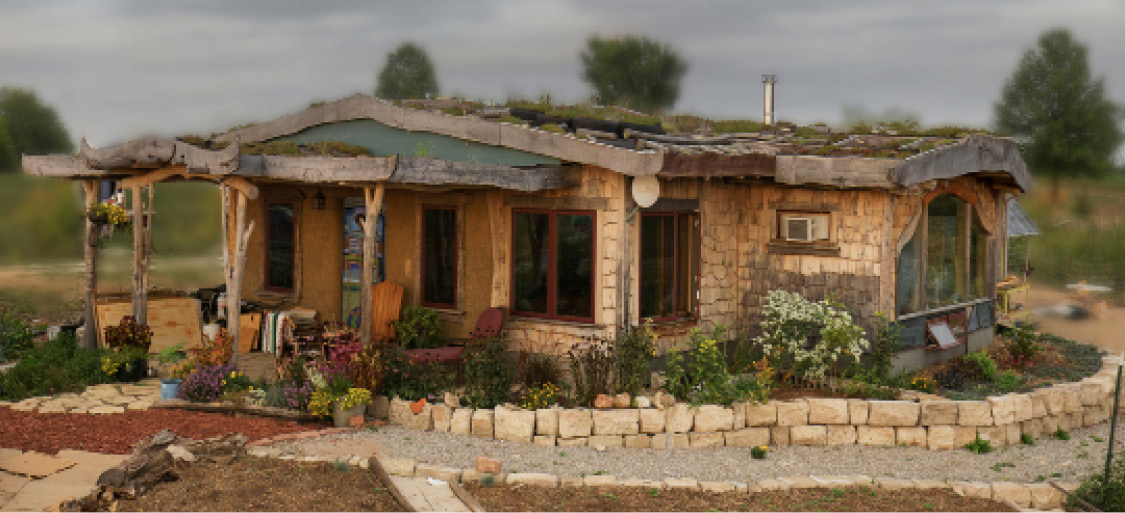
The FarmHouse at Hickory Highlands. Photo by Werner Elmker
Our journey began with a search for the right building site. We had already begun looking at numerous parcels of land before the fire, but that event gave us new focus. Eventually, we found an overworked 54-acre livestock and grain farm outside of Fairfield that had woods, a pond, and a rise on which to situate the house, which would provide us with an unobstructed view of the horizon, as well as a slight southerly slope which would allow the north wall to be bermed (tucked into the hill), reducing the house’s visual intrusion into the landscape and providing shelter from the winter winds. It was perfect for our needs.
Now that we had a place to put the house, we began to look at the other features of the acreage. There were stands of timber with hardwood trees of a dozen species. A few of these would be harvested and sawn into boards at a nearby mill to become the house’s trim, cabinets, doors, and furniture. There was also a pond which would provide water storage for domestic and agricultural use. As we considered these bounties, the floor plan of the FarmHouse began to come into focus.
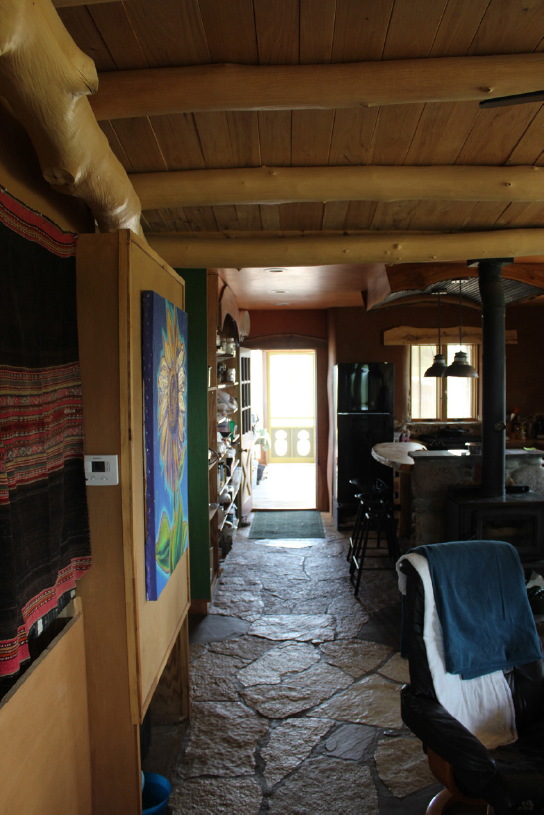
The view from the FarmHouse’s front door to the screened porch. Photo by Emily Mamrak
The house length would be oriented east-west. It would turn its back on the winter wind, and its south wall, with its large windows, would offer a view of the pond and the woods, as well as collect heat on sunny winter days. We decided the entry to the home would be via a stone-floored west porch. Anyone entering the snug foyer would get a glimpse of the gracious living-space within. We wanted a pathway of limestone flagstones which would lead from this beginning, through the house, past the living room, kitchen and out the east door to a screened porch. Along the north wall, we would put a guest nook, a mechanical room, a bathroom and, on the northeast, the master bedroom.
There were other, less obvious decisions we made as well—features of the house which wouldn’t immediately be evident to the eye, but which would reflect our values and our concern with sustainability.
Susan brought a particular set of skills to the creation of FarmHouse’s structure. While I had been a builder by profession, Susan had had numerous careers. None had been as fulfilling for her as house carpentry, or building exterior walls with straw bales and covering and protecting the bales with earthen plaster. She had also taught the building of benches and ovens with a mixture of sand, straw bales, and clay from the nearby ground—a combination known as “cob”.
For straw for our east and west exterior walls we turned to a neighboring organic farmer who supplied us with wheat straw bales. Straw bales have been used as building blocks since 1896 in Nebraska; they hold heat well in the winter and coolness in the summer. They resist penetration by wind, resist combustion and are a readily available local resource. Beyond these obvious advantages and their value as insulation, though, we love the look and feel of walls which are two feet thick, covered with earthen plaster and decorated with curved window wells.

“Stained glass”—made from blue bottles—in the bedroom. Photo by Emily Mamrak
To add to our knowledge of and experience with building with bales and earth, we attended workshops with Bill and Athena Steen, the founders of the Canelo Project in southern Arizona. They increased our knowledge-base many-fold during these events, and this knowledge enhanced both the structure and beauty of our FarmHouse.
For the clay to cover our straw bales, we knew we could turn to our own land. A foot beneath the topsoil was a layer of clay subsoil whose properties make it an excellent building material. It is sticky, it combines well with sand (to resist cracking) and straw (to provide a matrix which holds together on walls). Its resistance to moisture makes it usable as a plaster, a floor finish, and a material which is excellent for sculpting benches, earth ovens, even walls. The corner of the sunroom in the photo on p. 16 features a bench of cob.
As we continued to develop our vision, one of the greatest sources of support, in both the figurative and literal sense, came from the farm’s hickory trees. Their beauty and abundance at the farm’s higher elevations gave rise to the name Hickory Highlands. The idea of employing trees as structural members had first occurred to us during a day of scouring magazines years before. In several of the magazine features which caught our eyes, we saw photos of houses that had been designed by Roald Gunderson of Wisconsin, who was practicing what he called “whole-trees architecture”. Typically, trees are sawn into timbers, lumber, or boards to be used for construction. Gunderson’s idea was to use trees that are unmilled—or “whole”—as posts, beams and rafters, i.e. the frame. After we visited several homes he designed in Wisconsin, we decided to follow his system and use whole trees as the frame for our living room. We forwarded him the floor plan we had designed to that point, and commissioned him to create two exterior elevations which reflected his whole-tree aesthetic. Those drawings remained a source of inspiration for us during the years of construction. Gunderson has stopped by to visit several times when he has been in the area.
Susan and I determined that one of the most important features we wanted the house to have was a living room with a barrel vault (curved) ceiling. Hickory trees mostly grow straight and tall, but in our stand of timber there were two hickories which had matching, curved trunks. This was only one of many such serendipitous occurrences which helped us in our building of the FarmHouse. These trees provide the defining ceiling/roof beams which made the barrel vault we wanted possible. The eight- to eleven-inch diameters of these trees determined the nine- to ten-inch diameters of the supporting posts and the six- to seven-inch rafters. Consulting with Roald Gunderson, we learned that harvesting trees in the spring, when the sap is running, would allow the thick bark to peel off easily. When we had harvested our hickories and debarking was completed, it revealed a shimmering sapwood of surreal beauty, which has been a source of continuing amazement for our visitors.
We completed other architectural elements in the FarmHouse without considering, “How long will this take?” Our friend Dennis Kossow, working an hour or two a day for many weeks, built our hearth using stones from my grandfather’s Wisconsin farm, and I think the finished product conveys strength with an air of whimsy. Our rainbow-colored soffit boards are made of cottonwood sawn at the nearby mill. The honey locust boards which face the kitchen cabinets were sanded at a diesel-powered Amish shop. Susan laid the flagstone path leading through the house using limestone from the quarry in Anamosa, Iowa. It’s likely that the same quarry provided limestone for the Sullivan-designed jewel box bank in Grinnell and the Wright-designed Miller home in Charles City.
Susan and I did most of the work on the FarmHouse. As artisan-builders we had lots of support in our desire to build with local materials: our friend Lou Bolster brought us a case of blue bottles for the “stained glass window” in the bedroom. Neighbors with fallen-down barns allowed us to salvage weathered siding for wall coverings and rusted, corrugated roofing for ceiling material. We found a double drainboard cast-iron sink on Craigslist and made the trip from Des Moines to Fairfield with it strapped to the top of our car. Windows and doors came from the ReStore, and even from the roadside. We found resources as we needed them.
These included “human resources.” We had a few interns along the way—our first interns being Joshua Vojtisek, Emily Breffle, and Jacob Roberts—students from the Maharishi University of Management Sustainable Living Program, who worked alongside us on the first six, very hot weeks of construction, raising the FarmHouse from bare earth and seeing it through until we had a roof which would shed water. They have all been back to visit and view the project as a significant chapter in their lives.
We also depended on the skilled work of a number of sub-contractors. I did a work-trade with a friend, Eric Hoffman, helping him install siding on his house and then he helped shingle the walls of our house. Tony Stenger, who has a painting studio in one of the four “tiny home” structures which are also on the farm, built the rustic, undulating urbanite retaining walls around the FarmHouse, and he painted a pastoral scene on our salvaged front door (see this issue’s front cover).
We’ve also hosted occasional work parties. We are grateful for all this assistance. The FarmHouse could not have been completed without it. Along with our vision, our connection with the land and the materials, it was a big part of what kept us going for six years.
Our years of building experience allowed us to make design decisions as we built. I made mockups and drew sketches to communicate ideas for solutions to design issues. To work out every detail of construction before building would have been tedious, cumbersome, and unnecessary.
That being said, we carefully designed FarmHouse’s numerous support systems—heating, cooling, water, black water, and electric—with an eye toward sustainability and redundancy. Take cooling, for example: there are abundant operable windows, allowing for good ventilation. Transoms above the bedroom and bathroom doors allow for air movement even when the doors are closed. In the summer, windows are open at night to allow the cool air to flow into the house, then are closed in the morning to keep the coolness in and warmth out. Porches to the east and west combine with eave overhangs to keep the sun from overheating the house. Sun shades on the east bedroom window and the east bump-out window keep the summer morning sun out while allowing a diffused light in. A ceiling fan in the living room gently moves air around the entire house. We also installed two 100-foot-long, six-inch tubes eight feet deep in the earth. A fan drives filtered outdoor air slowly through the tubes, where it picks up the earth’s latent 58-degree temperature and delivers the chilled air into the house. Finally, on sunny summer days, when extra coolness is welcome, there is enough solar electricity generated by our off-grid system to run a small window air conditioner.
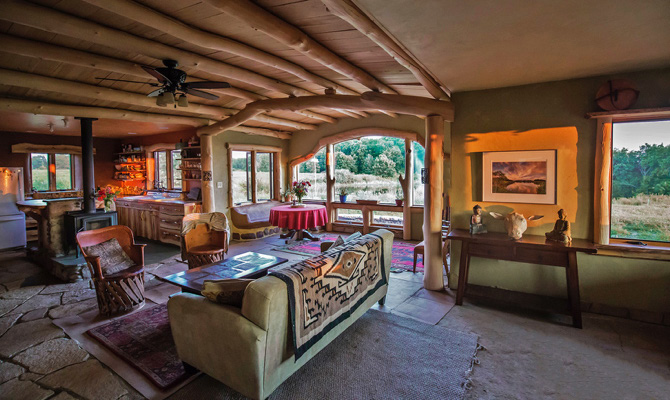
The FarmHouse’s great room, featuring the barrel-vault created with hickory logs harvested on the property. Photo by Werner Elmker
How much did the FarmHouse cost to build? Materials, subcontractors and tool rental totaled $155,000, not including land. Susan and I spent approximately 24,500 hours over six years. At one dollar per hour, that’s $24,500. Add in the hundreds of hours of service friends and interns put in—hours which were great fun, but impossible to put a price-tag on—and the cost—and the value delivered—quickly becomes incalculable.
We have enjoyed living in the house for two years. In fact, we have a hard time leaving, even to make the two-mile trip to town. We love that it looks as if it has emerged from the earth, just like the trees which make its frame. It has a casual, pleasing feel, like a favorite shirt or song. Tucked into its site, its west entrance is partially concealed by raised gardens along the curving entry walk which feature an eclectic mix of annuals and perennials, flowers and trees, weeds and edibles. Buffering the winter winds is a row of conifers 70 feet northwest of the house.
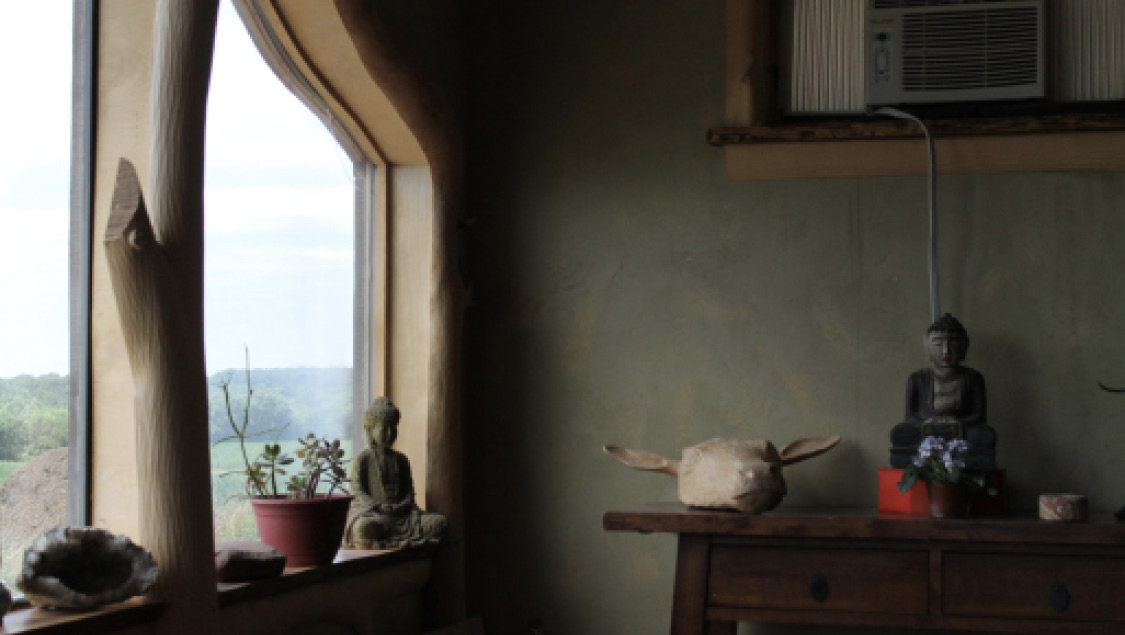
Detail of the south-facing window in the FarmHouse’s great room. Photo by Emily Mamrak
Once a year now, we host an open house to expose visitors to new possibilities in home design and to show them that it’s possible to build with natural, recycled or upcycled materials obtained from close by. We occasionally hold a house concert, preceding it with a potluck meal. These events are unique in that some people come only for the potluck, some only for the music, although most come for both. If we move some furniture out to the porch and bring in folding chairs, we can seat up to 50 people.
Once visitors had begun coming through the FarmHouse, we found that in building with natural materials and methods we had unintentionally evoked a multitude of traditions which spelled “home” for people from many different places. One visitor commented that the Dutch door between the kitchen and the screened porch reminded her of doors in her native Hungary. A woman from Venezuela put her hands on an earth plaster wall saying it reminded her of home. Another visitor, from Siberia, expressed happiness that we had included cow manure in our plaster mixes, just as her family did back in Russia. A professor from India said our three-part south window was reminiscent of windows in Rajasthan. Numerous visitors have commented that our adobe floors and round wood rafters—vigas—have the flavor of the American Indian and Spanish architecture of the Southwest. And earthen roofs like ours are used in many places in the world, including Scandinavia, where my own ethnic roots lie.
Guests and visitors enjoy the views from the FarmHouse. The porches, the windows, and the seating provide inspiring vistas of sunsets, mists over the forests, creek valley, pond and fields. But more significant than the views are the abundant beauty, silence, comfort, charm, and joy which are native, embedded qualities of the land. These characteristics were not inherent in our plan and elevations, nor were they even our intention as owner-builders. Rather, they were embodied, I think, in the local materials, whose living essence flowed from them as they were lovingly harvested from field or quarry or woodland, installed, and appreciated. Paying attention to their silent language has yielded a home which, like the forest itself, is pleasing, peaceful, and lively.
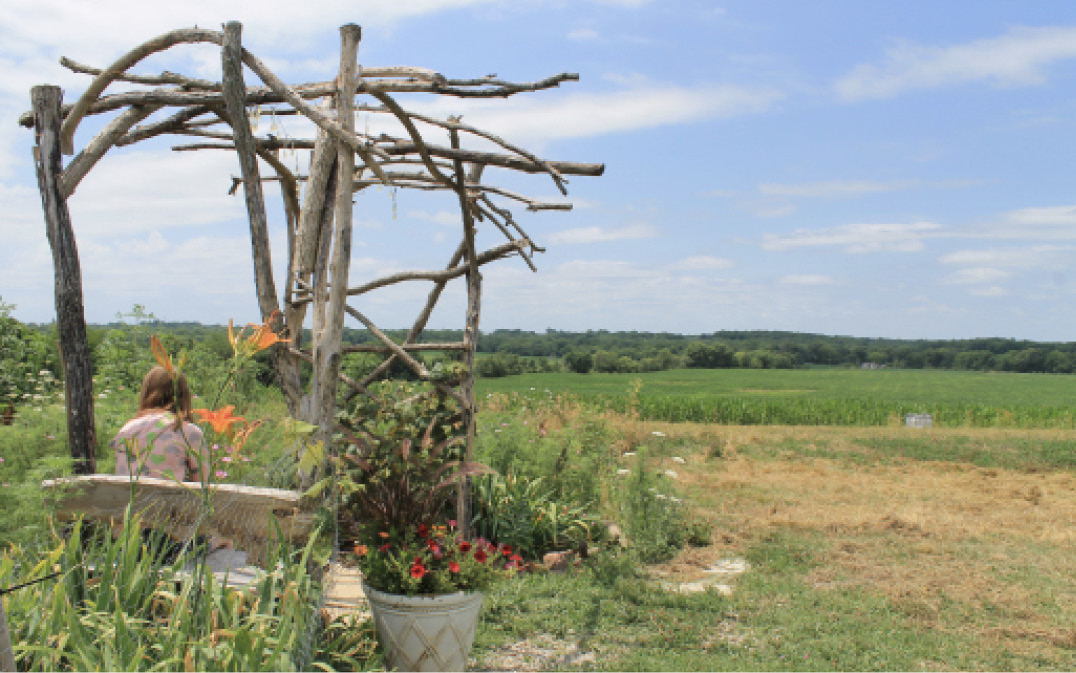
The view west from the FarmHouse’s dooryard. Photo by Mary Rose Bernal
What would our advice be for a person wanting to live in a home like the FarmHouse? Practice swinging a hammer, wielding a chainsaw or using whatever tools you need to accomplish your goal. Take workshops focusing on your favorite materials or techniques—straw bales, cord wood or earth plaster. Build something small and useful—a greenhouse, a tool shed or an animal shelter. Volunteer to work for people who are doing what you wish to do. Pick your place to build. Spend time there, and the place will speak to you.
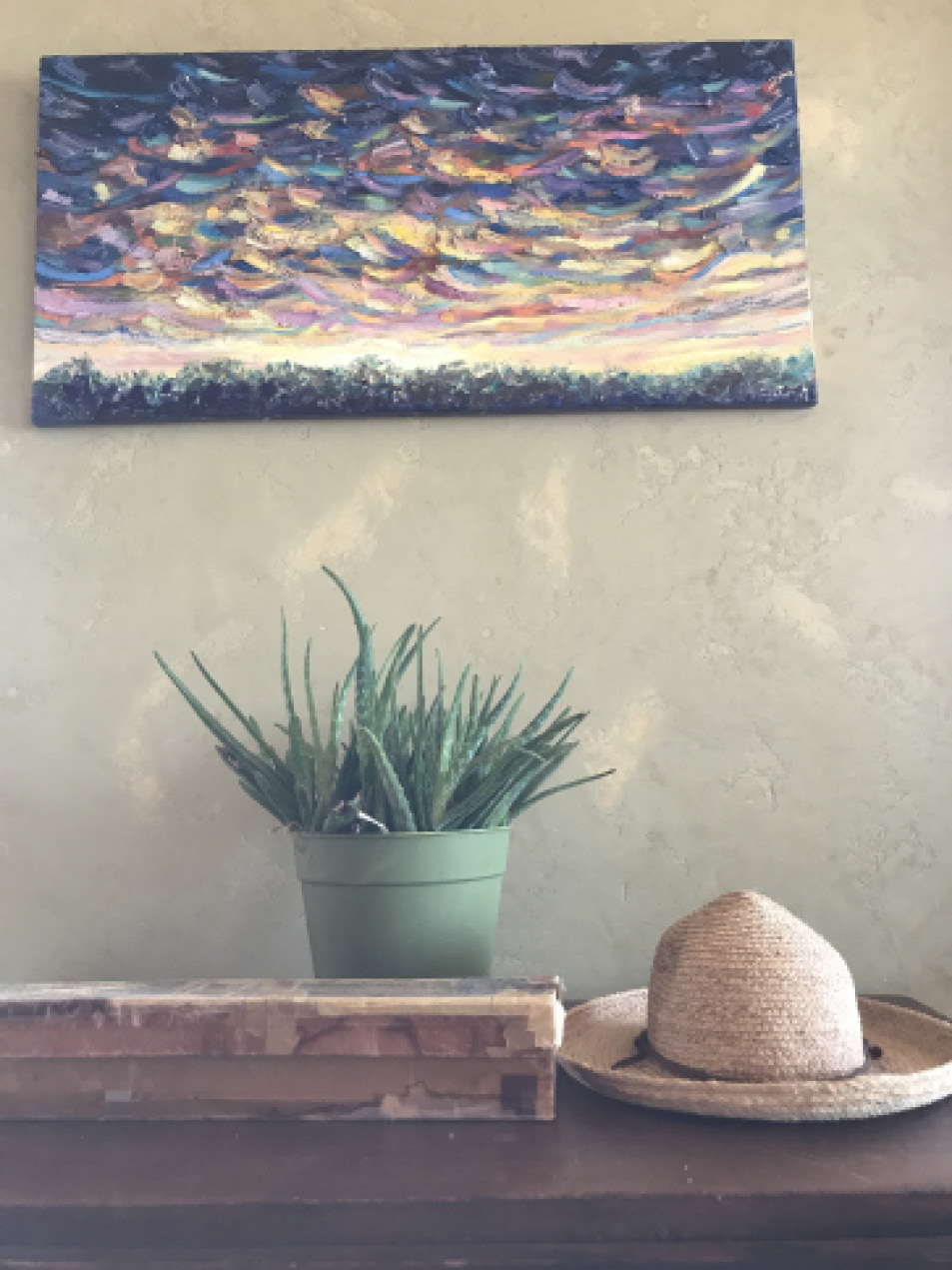
Photo by Emily Mamrak


